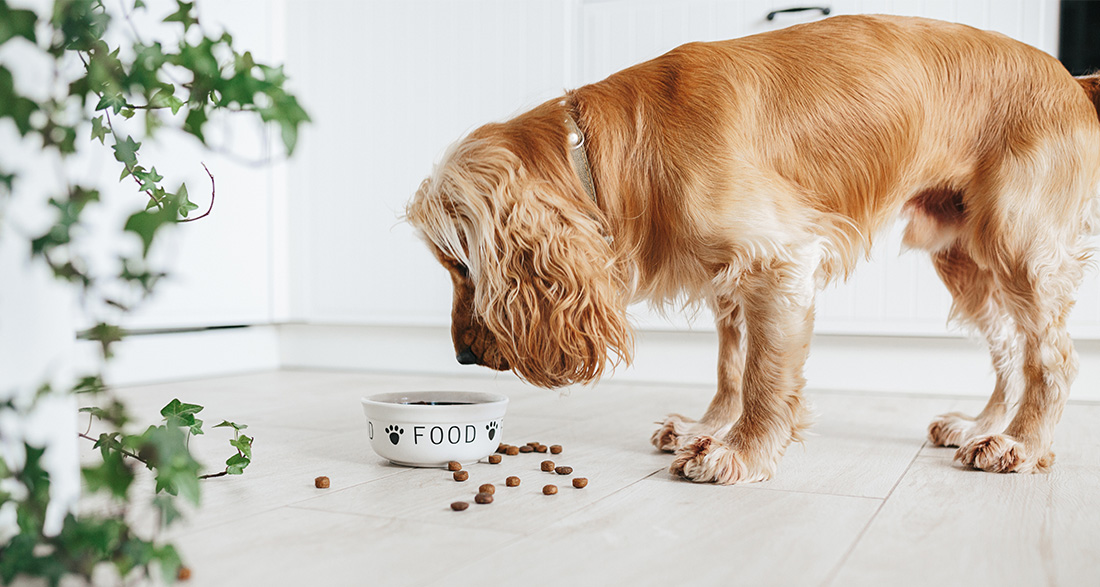If your dog is scratching more than usual, lethargic, and you suspect an allergy to the food, find out how to recognize the allergy, how the diagnosis is made, and what you can do to support your dog.
- Food Allergy and Intolerance in Dogs: Symptoms, Diagnosis, and Treatment
- Definition: What Is a Food Allergy in Dogs?
- Diarrhea, Itching, Lethargy: Symptoms of Food Allergy
- When Does a Food Allergy Show in Dogs?
- Which Food Components Are Dogs Allergic To?
- What Food to Feed a Dog with Food Allergy?
- Exclusion Diet as an Allergy Test: Diagnosis and Treatment of Food Allergy
Food Allergy and Intolerance in Dogs: Symptoms, Diagnosis, and Treatment
When your beloved four-legged friend is increasingly scratching, has patches of hair loss, and digestive issues, you may be dealing with an allergy or intolerance to one or more ingredients in your dog’s food.
Allergies are not a rare condition: About one in five dogs is allergic or intolerant to food. Such allergies don’t always exhibit the expected symptoms, so a closer look is worthwhile. Learn how to recognize a food allergy and how you can help your dog.
Definition: What Is a Food Allergy in Dogs?
The term intolerance is often confused with an allergy in daily life. When people talk about a food allergy for dogs, they usually mean intolerance because a genuine allergy is very rare. Complicating the differentiation is the fact that both conditions exhibit similar symptoms.

The crucial point is that a true food allergy requires an initial contact without symptoms because the immune system reacts only upon the second exposure to the substance. Antibodies formed during the first contact signal to your furry friend’s body, “Hey, something dangerous is coming, let’s give it our all!”
With intolerance, your dog’s body shows symptoms already at the first contact. Since these symptoms are similar, it’s worth taking a look at the symptoms of food allergies and intolerances.
Diarrhea, Itching, Lethargy: Symptoms of Food Allergy
The symptoms of allergies and intolerances are extensive. Most dogs show significant changes in skin and coat as well as in the digestive system. Signs include:
- Itching and hair loss
- Open sores on the skin (lick eczema and hot spots)
- Licking affected skin areas
- Digestive problems like diarrhea, abdominal pain, and vomiting
- Ear infections, especially in the outer ear canals

When Does a Food Allergy Show in Dogs?
Usually, your dog doesn’t react immediately with all symptoms if they cannot tolerate a specific food. It takes several weeks to notice if an ingredient is causing stomach issues for your dog. On average, the immune system or the gastrointestinal tract takes one to two weeks to develop symptoms.
Which Food Components Are Dogs Allergic To?
In cases of allergy or intolerance, protein sources are often brought into focus. Why? The compounds in protein trigger the reaction in the body. Often, allergy-inducing ingredients are meat types like chicken or beef, where there’s a higher likelihood that dogs develop an allergy or intolerance.
Wheat, soy, and corn belong to the group that most commonly causes intolerance in dogs: grains. Lactose also leads to symptoms in many dogs.

What Food to Feed a Dog with Food Allergy?
As part of the treatment, the veterinarian may prescribe hypoallergenic food. Hypoallergenic means that certain ingredients pose a lower risk for dogs to develop an allergy or intolerance. Hypoallergenic meat types (protein sources) include:
- Kangaroo
- Horse
- Goat
- Deer
- Water buffalo
Hypoallergenic plant-based carbohydrate and protein sources include:
- Sweet potato
- Quinoa
- Buckwheat (note: Pseudo-cereal and therefore well-tolerated!)
- Amaranth
Exclusion Diet as an Allergy Test: Diagnosis and Treatment of Food Allergy
Diagnosis and treatment for food allergies and intolerances in dogs are unified. But why? The method of choice for both diagnosis and treatment is the so-called exclusion diet. But why put your dog on a diet when they’re not overweight?
During the exclusion diet, certain components of the food are excluded – you guessed it. The ingredients of the food are broken down in the veterinarian’s office you trust. Then, certain ingredients are completely removed from your dog’s menu for several months (about 2-4).
Usually, an improvement in symptoms occurs after about 3-4 weeks during the exclusion diet. Digestive issues usually get better after about 2 weeks, and itching and open skin areas take about 4-6 weeks to improve. That’s why a sufficiently long time is necessary during which your dog only gets the food prescribed by the veterinarian. No unauthorized snacks, no bites from the kitchen table, as such actions can distort the diet’s results.
No snacks? Not entirely true – because if these are exactly the meat type in its pure form that your dog is already being fed as hypoallergenic food, snacks are allowed. Your four-legged friend can therefore test our hypoallergenic snacks, tailored to the meat they receive as hypoallergenic food, as much as they like.
After a successful exclusion diet, some veterinarians recommend a provocation test, where the old food is fed again for a short period to confirm the suspicion. Many dogs show reactions again, emphasizing that there is indeed an allergy or intolerance to the food.
In the case of a pure allergy, a blood test, for example, can provide quick insights, but in most cases, the diagnosis and treatment revolve around intolerance or intolerance.


